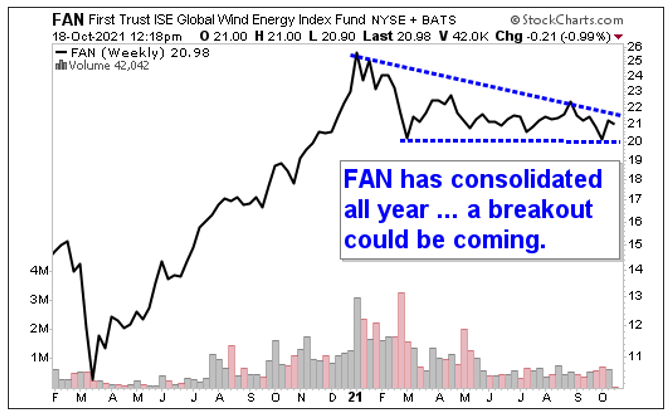The U.S. offshore wind sector could finally be taking off.
Last Wednesday, the Biden administration announced a plan to build seven mega wind farms in the Gulf of Mexico and the Gulf of Maine, as well as off the coasts of the Carolinas, California, Oregon and the Mid-Atlantic states.
It’s all part of an effort to provide clean energy to over 10 million households by 2030.
Electric power generation from wind has already grown by over 98% since 2000, from 6 billion kilowatt-hours (kWh) to upward of 338 kWh.
And that’s just in the United States.
With further advancements in technology, global wind power should continue to expand by leaps and bounds.
And as an investor, you should be aware …
• That participating companies could experience mega-profits.
The following sectors can give you exposure to wind energy:
Turbine Companies
Turbine companies manufacture, install and service wind turbines. And with turbines accounting for up to 30% of a wind farm's expenses, turbine manufacturers are some of the biggest beneficiaries.
The following companies stand to get a nice portion of the estimated $40—$50 billion to be spent on offshore wind turbines through 2035.
• General Electric Wind Energy, a subsidiary of General Electric , has installed over 49,000 turbines in more than 35 countries. And since the parent company has operations in aircraft engines, electrical motors, software, healthcare and weaponry, the share price is impacted by far more than just the performance of the wind energy subsidiary.
• Siemens Gamesa Renewable Energy engineers, designs, builds and sells wind turbines. It also constructs wind farms. It has two segments: wind turbines and operations, and maintenance. The company has deployed over 107,000 megawatts in over 70 countries.
• Vestas Wind Systems (OTC: VWDRY) has been the top supplier of wind turbines worldwide for five years, supplying 85 countries with almost 80,000 turbines. The Denmark-based company has factories in several countries, including the U.S., China and Spain.
• TPI Composites manufactures composite wind blades as well as precision molding and assembly systems. The Arizona-based company, which has 13 plants covering over 500,000 square meters in five countries, produced over 70,000 wind blades since 2001.
Wind Farm Companies
Wind farm companies develop large offshore and onshore wind farms capable of producing large amounts of energy.
• Orsted (OTC: DNNGY), another Danish company, is the world's largest offshore wind developer (and the second largest company in Denmark). It owns two of the largest offshore wind farms in the world: London Array and the Walney Wind Farm, both of which are located in the United Kingdom. It’s also built two pilot offshore wind projects in the U.S. off the coasts of Virginia and Rhode Island.
• Avangrid , Eversource Energy , Equinor ASA , Dominion Energy and Royal Dutch Shell are some other players to keep on your radar.
Wind Energy Companies
Wind energy companies distribute the energy produced by wind farms.
• NextEra Energy is at the forefront. This Florida-based utility,which uses a combination of wind, solar, natural gas and nuclear to generate electricity, has risen to become the world’s largest utility company in terms of market cap. And it’s almost tripled its wind energy capacity over the past decade.
Supply Chain Companies
The U.S. offshore wind industry will need to create a supply chain to include specialized ships for transporting and installing wind farm components. That means miles of high-voltage cables and offshore substations will be required to handle the power generated by these farms.
Capital spending in the U.S. offshore supply chain alone could easily reach $200 billion by 2035.
• Investors should watch oil and gas equipment company NOV , offshore vessel companies Seacor Marine Holdings and Tidewater and marine vessel manufacturer Gulf Island Fabrication .
An Exchange-Traded Fund (ETF) Play
A simpler approach to get broad market exposure is to buy shares of the First Trust Global Wind Energy ETF , which tracks the ISE Clean Edge Global Wind Energy IndexTM. To be included in the index, a company must be actively engaged in some aspect of the wind energy industry.
Let’s look at a weekly chart of FAN:
 |
You can see that FAN roared higher off the pandemic lows last year, but it’s spent this year consolidating in a tight range. I believe a breakout is coming — a breakout that could send FAN much higher.
The expense ratio for FAN is a reasonable 0.61%. A bonus is a dividend yield of 1.05% while you wait for potentially hefty capital gains.
So catch these trade winds while they’re a blowin’!
All the best,
Sean

